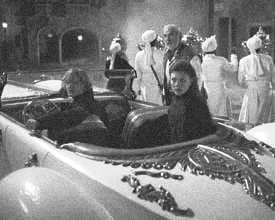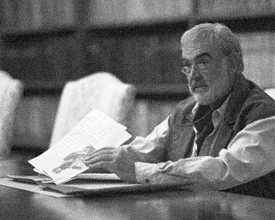|
||||||
 |
|
The League of Extraordinary Gentlemen It's better than The Avengers
|
|
Depending on how high
you set the bar, the last time Sean Connery was good for a picture
was either The Rock or The Untouchables. So whether
it's 7 or 16 years, it looks like the old dog can't even do his old
tricks. With all the talk of power battles on the set and the lion's
share that he takes from what should be a team picture, one can only
presume that Connery should at least split the blame check with director
Stephen Norrington. Norrington didn't go this far wrong with Blade,
but he certainly showed potential for such a colossal failure.
The locations are European and most of the characters are British,
but League of Extraordinary Gentlemen is— to quote the picture
itself— "Very American. Fire enough bullets and hope to hit the
target." The film itself doesn't so much fire a bunch of bullets
as it misfires for a while until the gun jams.
Based on Alan Moore's graphic novel, The League of Extraordinary
Gentlemen features a whole slew of literary heroes from the
19th century and bands them together to save the British Empire.
Given the sources from which Moore culled his gentlemen, there will
be much talk about the dumbing down of these characters for the
film, but that is not where the problems arise. None of the characters
are from anything all that high cultured and when going from the
page—even the drawn one—to the screen, most characters have to be
simplified as a result of the limits of the medium.
Comic book fans have long seen adaptations that treat the subject
matter as unsubstantial fare because the word "graphic" overshadows
"novel," but League goes even farther. Existing in a world
of Looney Tunes rules where every bomb is a loudly ticking time
bomb and cloaking it all in the snickering seriousness of a SNL
Masterpiece Theater parody, the picture doesn't just fail to entertain,
but fails to make any sense.
Dorian Gray displays fearlessness in face of death as he knows
his enchanted portrait protects him, but apparently he was painted
in the suit he wears throughout the picture. The bullet holes he
is riddled with not only close up on his flesh, but a shot later,
his outfit is as natty as can be. In a shot almost lost to the clumsy
editing, we see that the gigantic Mr. Hyde has had a top hat made
that would engulf most men's shoulders, but hasn't bothered to find
a shirt of equally monstrous proportions. It's not that these instances
aren't handled well; it's that they aren't handled at all.
This picture looks for laughs of recognition, not of surprise
or delight. The only line that jostles even a chuckle from the crowd
is a "Call me Ishmael" joke. It's not really so much a joke as it
is that someone says it, and people laugh because they've heard
it elsewhere. An attempt is made with the line "This monkey has
terrorized the Rue Morgue for months," but a picture continually
trying to move too fast for people to notice all the problems is
really asking too much for the audience to pull anything heavier
than "Nevermore" out of their Poe reference packs.
Sure, every review will bring up "it's so nice to finally see
Captain Nemo played with his original ethnicity intact," but that
means he has become ungodly dull in the name of Political Correctness.
On the other hand, Dorian Gray only has eyes for Mina Harker and
doesn't cast so much as a side glance at the nubile Tom Sawyer.
Oscar Wilde has just looked up from his heavenly orgy to see Jules
Verne giving him the finger.
At least Tom Sawyer cusses a few times, even if it is lost to
ratings edits, but for a character whose defining skill is craftiness
he comes off rather thick headed. We can't be that surprised, with
a dull witted Allan Quatermain as his father figure. The old lion
lectures the young river rat about taking his time with a shot,
but the first time Quatermain makes a move he unloads at the armor
plated chest of some drones when their faces are unprotected. Not
to be outdone, Sawyer doubles the ante by emptying two Colts at
a baddie in a full suit of armor.
Maybe Quatermain should be cut some slack as he's gettin' too
old for this shit and can't see without his glasses when the script
calls for his poor eyesight to be an issue. Connery plays Quatermain
somewhere between an Arnold-style punch line machine and bad impression
of himself. The main problem is Connery's portrayal of Quatermain
as one of the most played-out action clichés, the hero on the cusp
of old age. Connery defined the part with his over-the-hill Robin
Hood in Robin and Marian. That was 1976, but here we are
28 years later and Connery hasn't just stopped aging but has tried
to turn back the clock. His Robin was too old for adventuring, collapsing
winded after scaling the castle wall, but forced into battle one
more time. His Quatermain needs his cheaters but hasn't really lost
a step and is just starting to get too old.
One such moronic sequence involves a message left on a "recording
disc." It's a standard gloating-message-from-the-villain sequence,
but seeing how watching our main characters react to new pieces
of information might prove dramatic, and therefore out of character
for the rest of the film, we cut instead to the characters recording
the message. Since it's 1899 and film has only been around 5 years
the scene is shot on scratchy black and white at 16 frames per second.
Why this film is edited and more than one shot would be too much
to ask, but why the film has been watched enough times to be very
scratched up and full of jump splices where the film has broken
is explainable only with ignorance. Since old movies look like
that now, they must have always been that way. That theory could
have sure saved the makers of Jurassic Park some time by populating
the island with huge chunks of fossil.
It's not that one expects realism in a film like this, poetic
license and all, but most of these problems serve to sabotage the
illusion of reality, however fantastic. The fact that in both scenes
above deck on the Nautilus there isn't even the slightest breeze
to ruffle a single hair isn't just a sloppy filmmaking or a continuity
error —of which there are many. It undermines the plot point that
the vessel is tearing through the waters with blinding speed. Why
is it that we see Mina Harker, a vampire and scientist, tending
to injured crew members when Dr. Jekyll is demoted to delivering
bandages?
Jekyll, or more properly his bigger half, Hyde, presents an interesting
problem. In a picture that features some of the worst looking CG
effects ever, Hyde appears as an interesting mixture of computers
and prosthetics. His transformation is thankfully done without standard
morph effects, but with editing. Even if the final product doesn't
quite work, one has to respect a nice nod to the old ways.
Of course many will draw the parallel between Hyde and this summer's
other four letter H-monster, and they do make an interesting pair.
The problem with Hyde is the fact that he is only a physical transformation.
Early on they try to play some of the Id vs. Super-ego games, but
when the chips are down not only is Hyde super-strong and vicious
but also smart enough to figure things out. If Hyde has the reasoning
abilities of Dr. Jekyll then Dorian is right to ask the good doctor
what good is he without his monster. The fact that in a fist fight
Hyde takes three punches to the face before blocking another and
then delivering a devastating blow makes the Hulk he resembles a
little less Incredible and a little more Hogan.
All of these characters, save one, have been in other, better
films. The League's Invisible Man isn't the scientist from the H.G.
Wells story, not that most of these characters are as they were
written, but they do all go by the same names. As a personality,
his gentleman thief charms but as a skill his invisibility seems
fairly limited. Throughout the picture, characters spot the invisible
ones and blunder through rooms without noticing non-hiding visible
ones.
The fun of this film's concept comes from mixing all of these
classic characters together but when that which makes these characters
classic is ignored and not even replaced with something else, all
of that promised fun runs out, leaving an empty soulless shell.
The League of Extraordinary Gentlemen is an okay place to
start with an almost passable outline plot and some good characters
to play with, but unfortunately that's as far as it goes. Not a
single character goes beyond the clumsiest action clichés, and when
it's with characters that have already shown a great deal of promise
elsewhere it's 100 times worse.
|








 The League of Extraordinary Gentlemen isn't merely a simplified
version of literary characters; it's dumbed down from the spectacle-driven
summer movie level. Readers of the original sources aren't just
the ones being patronized—that can grudgingly be forgiven—it's that
fans of Con Air are being patronized—that cannot.
The League of Extraordinary Gentlemen isn't merely a simplified
version of literary characters; it's dumbed down from the spectacle-driven
summer movie level. Readers of the original sources aren't just
the ones being patronized—that can grudgingly be forgiven—it's that
fans of Con Air are being patronized—that cannot.
 He
muses that the old tiger grows fiercest just before he dies. Later,
while he sits contemplatively in the snow, a white tiger wanders
out of the drifts and the two eye each other before parting ways.
The scene comes off a little cheesy and a little on the nose but
not egregiously so. An example of one of the film's problems comes
when Nemo steps out of the cave to ask if that was an old tiger
looking for a place to die. The picture insults the audience's ability
to spot an overplayed metaphor or even recognize standard locations,
considering a shot of some docks overtitled with "East London Docks,"
but then expects it to pick up an off-handed reference to Reichenbach
Falls. What could have been at the very least smart and visceral
fun plays leaden and idiotic.
He
muses that the old tiger grows fiercest just before he dies. Later,
while he sits contemplatively in the snow, a white tiger wanders
out of the drifts and the two eye each other before parting ways.
The scene comes off a little cheesy and a little on the nose but
not egregiously so. An example of one of the film's problems comes
when Nemo steps out of the cave to ask if that was an old tiger
looking for a place to die. The picture insults the audience's ability
to spot an overplayed metaphor or even recognize standard locations,
considering a shot of some docks overtitled with "East London Docks,"
but then expects it to pick up an off-handed reference to Reichenbach
Falls. What could have been at the very least smart and visceral
fun plays leaden and idiotic.
